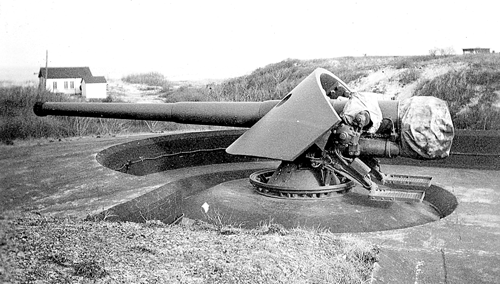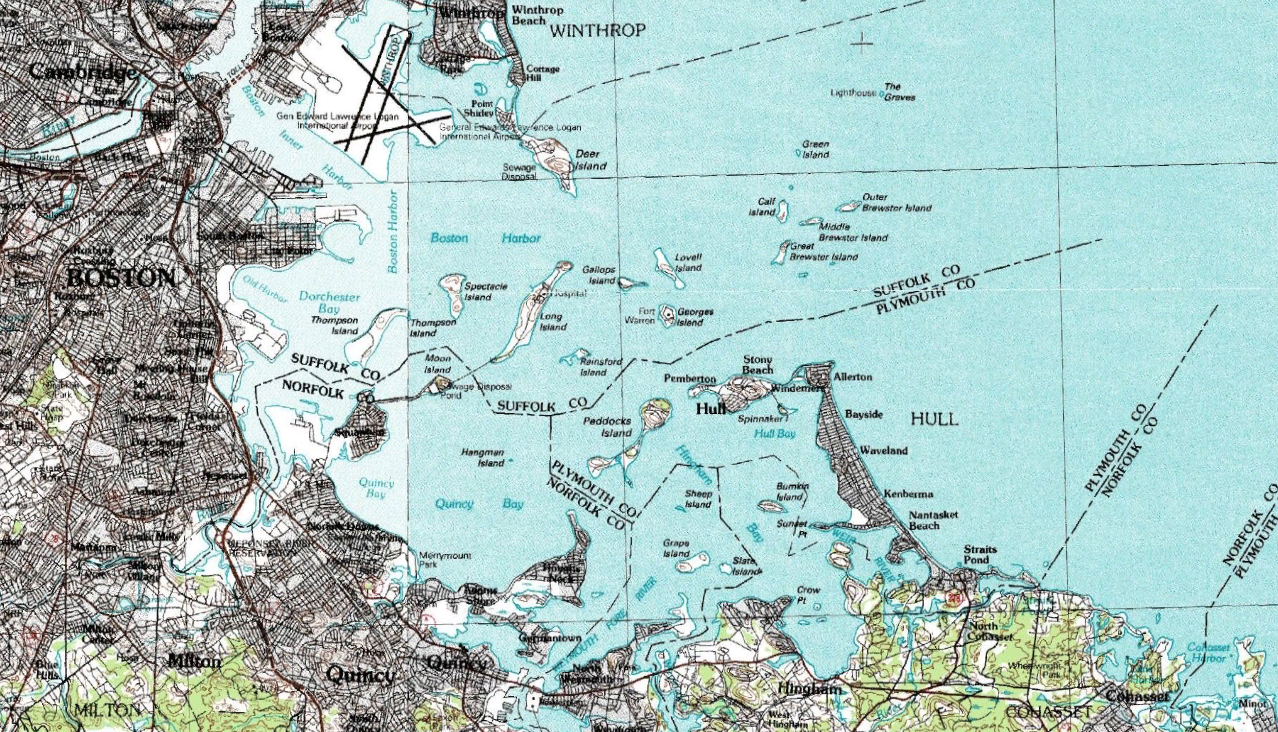|
Fort Dawes
Fort Dawes was a World War II Coast Artillery fort located on Deer Island in Winthrop/Boston, Massachusetts. It was part of the Harbor Defenses of Boston. History The site's military history began in 1906 as the Deer Island Military Reservation, acquired for fire control and mine field control as part of the Taft program. During World War II, Fort Dawes was initially the site of a target detection radar for the harbor defenses and Battery Taylor (two 3-inch M1902 guns moved from nearby Fort Strong), both completed by late 1942. Also in 1942, construction began on Anti- Motor Torpedo Boat Battery (AMTB) 944, with two fixed and two towed 90 mm guns, along with the Harbor Entrance Control Post (HECP) for Boston Harbor--the installation that kept track of all vessels entering and leaving the harbor. AMTB 944 replaced Battery Taylor in October 1943, whose guns were placed in storage at that time.Berhow, p. 205 By 1945 Fort Dawes had a mine casemate controlling some of the mine ... [...More Info...] [...Related Items...] OR: [Wikipedia] [Google] [Baidu] |
Harbor Defenses Of Boston
The Harbor Defenses of Boston was a United States Army Coast Artillery Corps harbor defense command. It coordinated the coast defenses of Boston, Massachusetts from 1895 to 1950, beginning with the Endicott program. These included both coast artillery forts and underwater minefields. The command originated circa 1895 as the Boston Artillery District, was renamed Coast Defenses of Boston in 1913, and again renamed Harbor Defenses of Boston in 1925.Stanton, pp. 455-481Rinaldi, pp. 165-166Berhow, p. 430-434 History Early Boston forts Colonial period Boston Harbor's principal coastal fort of the colonial era was Castle William, whose site was first fortified in 1634 and called "the Castle" until 1692, when it was renamed for William III, the King of England at the time. It is one of the oldest continuously fortified sites in the northeastern United States; however, the site of Fort William and Mary near Portsmouth, New Hampshire was fortified at least two years previously. T ... [...More Info...] [...Related Items...] OR: [Wikipedia] [Google] [Baidu] |
Fort Strong
Fort Strong is a former U.S. Army Coast Artillery fort that occupied the northern third of Long Island in Boston Harbor. The island had a training camp during the American Civil War, and a gun battery was built there in the 1870s. The fort was built in 1893-1906 during the Endicott period of expansion in U.S. coast defense, and was part of the Coast (later Harbor) Defenses of Boston. Formerly, it was also known as Long Island Military Reservation. Before World War I, a large station for handling submarine mines was added to the fort's defenses. Prior to World War I the fort was probably manned by over 1,000 soldiers. During World War II, two batteries of 3-inch guns (Basinger and Stevens) defended channel minefields, but the big guns and other 3-inch batteries (except for the AA guns) were decommissioned. Declared surplus in 1947, the fort served as a Nike missile site until 1961, and was redeveloped in 2005-2009 for a children's summer camp and later a homeless shelter. Howev ... [...More Info...] [...Related Items...] OR: [Wikipedia] [Google] [Baidu] |
Forts In Massachusetts
A fortification is a military construction or building designed for the defense of territories in warfare, and is also used to establish rule in a region during peacetime. The term is derived from Latin ''fortis'' ("strong") and ''facere'' ("to make"). From very early history to modern times, defensive walls have often been necessary for cities to survive in an ever-changing world of invasion and conquest. Some settlements in the Indus Valley civilization were the first small cities to be fortified. In ancient Greece, large stone walls had been built in Mycenaean Greece, such as the ancient site of Mycenae (famous for the huge stone blocks of its 'cyclopean' walls). A Greek '' phrourion'' was a fortified collection of buildings used as a military garrison, and is the equivalent of the Roman castellum or English fortress. These constructions mainly served the purpose of a watch tower, to guard certain roads, passes, and borders. Though smaller than a real fortress, they acted ... [...More Info...] [...Related Items...] OR: [Wikipedia] [Google] [Baidu] |
List Of Military Installations In Massachusetts
This is a list of current and former military installations in the Commonwealth of Massachusetts. Current military installations in Massachusetts Joint facilities ;Bases * Joint Base Cape Cod (state designation, not federally recognized)USCG Air Station Cape Cod Official Site ;Centers * David S. Connolly Armed Forces Reserve Center * [...More Info...] [...Related Items...] OR: [Wikipedia] [Google] [Baidu] |
Seacoast Defense In The United States
Seacoast defense was a major concern for the United States from its independence until World War II. Before Military aviation, airplanes, many of America's enemies could only reach it from the sea, making coastal forts an economical alternative to Standing army, standing armies or a large navy. After the 1940s, it was recognized that fixed fortifications were obsolete and ineffective against aircraft and missiles. However, in prior eras foreign fleets were a realistic threat, and substantial fortifications were built at key locations, especially protecting major harbors. The defenses heavily depended on fortifications but also included Submarine mines in United States harbor defense, submarine minefields, nets and boom (navigational barrier), booms, ships, and airplanes. Therefore, all of the armed forces participated in seacoast defense, but the United States Army Corps of Engineers, U.S. Army Corps of Engineers played the central role in constructing fixed defenses. Designs evo ... [...More Info...] [...Related Items...] OR: [Wikipedia] [Google] [Baidu] |
9th Coast Artillery (United States)
The 9th Coast Artillery Regiment was a Coast Artillery regiment in the United States Army. History The 9th Coast Artillery was constituted 27 February 1924 and organized 1 July 1924 as the Regular Army (United States), Regular Army component of the Harbor Defenses of Boston (HD Boston), Massachusetts until early 1944; the 241st Coast Artillery (United States), 241st Coast Artillery was the Massachusetts Army National Guard, Massachusetts National Guard component of those defenses. On 23 February 1944 the 9th was relieved of this duty and soon deactivated as part of an Army-wide reorganization.Stanton, p. 456 Lineage Constituted 27 February 1924 in the Regular Army as the 9th Coast Artillery (Harbor Defense) (HD) and organized as a Type B regimentBerhow, pp. 488-495 at Fort Banks (Massachusetts), Fort Banks in HD Boston on 1 July 1924 from the following companies of the Coast Artillery Corps: 172nd, 59th, 113th, 120th, 136th, 137th, 177th, 178th, and 9th Coast Artillery band; o ... [...More Info...] [...Related Items...] OR: [Wikipedia] [Google] [Baidu] |
6-inch Gun M1
The 6-inch gun M1897 (152 mm) and its variants the M1900, M1903, M1905, M1908, and M1 (a.k.a. T2) were coastal artillery pieces installed to defend major American seaports between 1897 and 1945. For most of their history they were operated by the United States Army Coast Artillery Corps. They were installed on disappearing carriages or pedestal (a.k.a. barbette) mountings, and during World War II many were remounted on shielded barbette carriages. Most of the weapons not in the Philippines were scrapped within a few years after World War II. History In 1885, William C. Endicott, President Grover Cleveland's Secretary of War, was tasked with creating the Board of Fortifications to review seacoast defenses. The findings of the board illustrated a grim picture of existing defenses in its 1886 report and recommended a massive $127 million construction program of breech-loading cannons, mortars, floating batteries, and submarine mines for some 29 locations on the US coastline. ... [...More Info...] [...Related Items...] OR: [Wikipedia] [Google] [Baidu] |
Fort Duvall
Fort Duvall was a Coast Artillery fort, part of the Harbor Defenses of Boston, in Massachusetts. What was then called Hog Island in Hull, Massachusetts was acquired by the U.S. government in 1917, and the fort was constructed in the early 1920s. It had only one gun battery, Battery Long, but it mounted the largest caliber weapons in the entire harbor defense system: a pair of 16-inch guns. These were the 16-inch gun M1919, of which only seven were deployed; 16-inch weapons deployed later were supplied by the Navy. Circa 1920 the Brewster Islands Military Reservation and the Calf Island Military Reservation were considered for a 16-inch battery; at that time a twin naval-type turret was envisioned. However, Fort Duvall was built instead. In 1922 the fort was named for Major General William Penn Duvall (1847-1920). A graduate of West Point, Duvall was born in Maryland, was a principal assistant to the Army Chief of Artillery, and served two tours of duty in the Philippines (the s ... [...More Info...] [...Related Items...] OR: [Wikipedia] [Google] [Baidu] |
East Point Military Reservation
East Point Military Reservation was a World War I and World War II Seacoast defense in the United States, coastal defense site located in Nahant, Massachusetts. In 1955–62 it was a Nike missile launch site. As of 2016 most of the site is the Marine Science Center of Northeastern University. History The East Point Military Reservation was originally acquired by the US Army from the Lodge family in 1917. It originally consisted of a searchlight and an observation post. The site was planned to be named Fort Henry Cabot Lodge for the prominent senator on whose land part of the facility was built, but this was never acted upon. The site today The site today consists of towers, the foundations of buildings, and bunkers formerly for guns and ammunition. East Point Batteries The East Point Batteries, located in Nahant, Massachusetts, were part of the Harbor Defenses of Boston during World War II. Three separate gun batteries were built: Battery Murphy (two 16-inch guns), Battery 206 ... [...More Info...] [...Related Items...] OR: [Wikipedia] [Google] [Baidu] |
16"/50 Caliber Mark 2 Gun
The 16"/50 caliber Mark 2 gun and the near-identical Mark 3 were guns originally designed and built for the United States Navy as the main armament for the ''South Dakota''-class battleships and s. The successors to the 16"/45 caliber gun Mark I gun, they were at the time among the heaviest guns built for use as naval artillery. As part of the Washington Naval Treaty of 1922, both of these ship classes were cancelled part way through construction, rendering surplus about 70 examples of the 16-inch/50 which had already been built. Twenty were released to the US Army, between 1922–1924, for use by the Coast Artillery Corps, the rest were kept in storage for future naval use. Only ten of the twenty available guns were deployed (in five two-gun batteries) prior to 1940.Berhow, p. 61 When the design of the began in 1938, it was initially assumed these ships would use the surplus guns. However, due to a miscommunication between the two Navy departments involved in the design, the ... [...More Info...] [...Related Items...] OR: [Wikipedia] [Google] [Baidu] |
Boston Harbor
Boston Harbor is a natural harbor and estuary of Massachusetts Bay, and is located adjacent to the city of Boston, Massachusetts. It is home to the Port of Boston, a major shipping facility in the northeastern United States. History Since its discovery to Europeans by John Smith in 1614, Boston Harbor has been an important port in American history. Early on, it was recognized by Europeans as one of the finest natural harbors in the world due to its depth and natural defense from the Atlantic as a result of the many islands that dot the harbor. It was also favored due to its access to the Charles River, Neponset River and Mystic River which made travel from the harbor deeper into Massachusetts far easier. It was the site of the Boston Tea Party, as well as almost continuous building of wharves, piers, and new filled land into the harbor until the 19th century. By 1660, almost all imports came to the greater Boston area and the New England coast through the waters of Boston ... [...More Info...] [...Related Items...] OR: [Wikipedia] [Google] [Baidu] |








